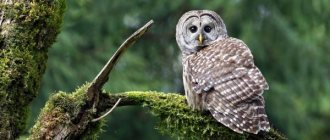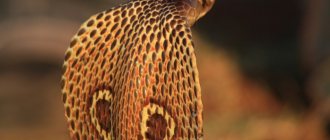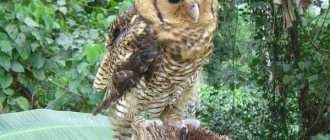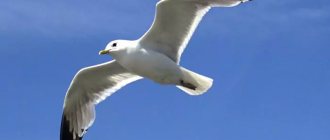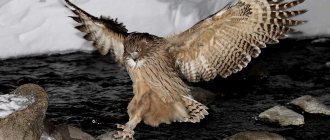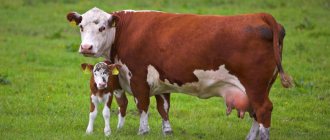Who is this owl?
The Eagle Owl is a large nocturnal hunting bird from the genus Bubo or Ketupa. It has a large head, a developed facial disc, and huge eyes with a bright red iris.
Eagle owl - a large bird of prey
It flies silently, does not rise high above the ground, makes circles, and soars in the air for a long time. When a bird sits on a tree or on the ground, its body is in an upright position. Making sounds, the bird bends forward and straightens its legs. The eagle owl is very similar to the long-eared owl, but it is much smaller in size.
Distinctive features:
- large barrel-shaped body
- thick plumage of copper-red color,
- expressive eyes of orange shades,
- feather ears are tufts of long feathers above the eyes that help the bird camouflage itself during the daytime.
At night, the feather ears are pressed against the head and become almost invisible. Lives in many countries of Eurasia, Africa, America. Found throughout Russia. Lives in mountains, forests, steppes, deserts, river valleys, rocky gorges, where there is sufficient food and a secluded place for nesting.
The common eagle owl is a sedentary, nesting bird, is not afraid of people, can live in parks, forest plantations, near populated areas, and on farms.
For reference! This is a very smart bird; many legends and superstitions are associated with it. Moreover, a variety of fairy tales can be found among different peoples.
Top 3: the most interesting facts about the eagle owl
- Among the ancient Romans, the eagle owl was considered a gloomy omen. On the night before the famous Battle of Cannae, eagle owls hooted around the Roman camp all night. The morale of the superstitious soldiers was undermined, and this was one of the reasons for the defeat of Rome.
- The age of an eagle owl can be determined by its eyes. As they age, they change color from light yellow to dark orange.
- In the wild, eagle owls live for about 20 years. But in captivity there are long-livers who die at the age of 60–65 years.
What does an eagle owl look like: description
These birds are quite large, depending on the species, they weigh from 800 g to 4 kg and reach sizes from 40 to 75 cm. The male’s wing length is 40-46 cm, and the female’s is around 42-52 cm. The wingspan in flight is 1.5 -1.9 m.
The eagle owl has thick, soft, loose plumage, which allows it to fly silently. The feathers on the wing have a special shape - the blades are curved and the tips are dissected, so that there is no rustling or friction during flight. There are even feathers on the fingers right up to the claws, so it easily tolerates any frost.
The wingspan of an eagle owl is from 1.5 to 1.9 m
- The color of the feathers depends on the habitat. Birds living in the western part of Siberia are almost white in color, and eagle owls living in the European part have a reddish-brown color with dark feathers.
- The upper part of the body, head and wings are always darker than the lower part. The facial disc has a light grayish-brown tint.
- A pattern in the form of drops can be discerned on the chest, and dark stripes on the stomach.
The chicks are densely covered with soft light gray down. There are dark spots only near the eyes. After two weeks, a blurred pattern appears in the form of transverse brown stripes. Two to three month old cubs become similar to adult birds, their plumage is no different.
Newborn chicks are covered with soft light down.
The eagle owl bird has strong, developed legs. He easily moves on the ground, hunts successfully, and knows how to defend himself well. Even one-month-old cubs move a long distance away from the nest. Their claws are long, strong, sharp, almost black.
The eyes are fixed, yellow-brown in color, they always look forward, the pupils decrease and increase with inhalation and exhalation. Vision is very good, the bird sees perfectly at a great distance, not only at night, but also during the day. Even a small amount of light allows him to navigate in space. But it only distinguishes black and white shades. The eagle owl's eyelids are light pink.
For reference! The bird has acute hearing, which allows it to hunt successfully even at night. Her head turns 200 degrees. The beak is sharp, thin, dark in color.
Eagle owls are endowed with a powerful, sharp voice; the sounds they make can be heard at a great distance (up to 3-4 km). The troop is especially noisy during the mating season at night. It is the males who make calling sounds. The calls of females and males alternate. Sometimes you can hear pairs of singing, like several birds shouting to each other. During the night, a bird can make sounds many times (up to 1000). The screams of some species resemble human voices, which instills strong fear in people.
When screaming, the feathers on the neck protrude, revealing light down. These white spots on the throat of an eagle owl are clearly visible in the darkness of the night.
Scientists distinguish about 10 different sounds that these birds can produce. Each of them has its own function. A powerful hum indicates that the bird is about to hunt. Changing the direction of flight, the eagle owl makes more extended sounds. There is an assumption that in this way the male lets the female know where he is. Specific sounds can be heard during times of danger. Hearing this cry, the chicks fall silent for a while.
Description of the bird
Photo of an eagle owl sitting on a piece of wood
- Eagle owls have red or buffy plumage. The rainbow is yellow.
- The body length of adults is from 60 to 70 cm.
- Weight is approximately 3 kg.
- The wingspan of the bird is from 150 to 180 cm.
The eagle owl's flight is silent, which is important during night hunting, when everyone in the forest is sleeping. Vision is very sharp. The eagle owl's ability to turn its head is also famous: they can turn it up to 270 degrees, making an almost complete rotation of the head around the neck. All these features make the bird an unsurpassed night hunter.
Differences between females and males
Males and females differ primarily in size. Females are slightly larger than males, have a wide wingspan, and are heavier in weight. But a lot depends on what the eagle owl eats. The sounds made by the female are lower than the calling calls of the male.
Females have brighter feather colors. Molting in females lasts longer than in males. Eagle owls are monogamous.
Note! What does an eagle owl do to attract a female's attention? The male sits high on a tree and calls the female, making specific sounds - hoots.
In some species, mating season occurs in March, in others in December. This ritual is repeated every year. Young males look for a mate in the same way. Then the female and male shout to each other in pairs, touch each other with their beaks, and bow.
LIFESTYLE
The eagle owl is the largest owl in the world. It inhabits most of Europe, Asia and North Africa. The eagle owl adapts to different conditions, but prefers areas near water bodies and areas where there are a lot of rodents. These animals are the main part of the prey of these birds of prey; they make up up to 90% of their diet.
The eagle owl spends most of its life alone. Sometimes it happens that a male and a female live in a common territory, but each of them has their own shelter and each of them hunts independently. The eagle owl jealously guards its possessions, the area of which occupies 15-80 km2.
The eagle owl is a nocturnal bird of prey, flying out to hunt after sunset. During the day, he sleeps in a shelter that is located in the roots of trees, in dense bushes or on a sunny ledge of a rock. Often he is awakened from sleep by flocks of crows and other birds, which scream loudly and can even attack the eagle owl. The eagle owl chased by them flies to another, quieter place. In the northern regions it flies out to hunt during the day.
Habitats
Eagle owls are found throughout Europe, Asia, Africa, North and South America. At the end of the 19th and beginning of the 20th centuries, the number of eagle owls decreased sharply. In Denmark, France, Germany, Benelux it is almost never found.
The eagle owl lives throughout Russia: in the European part, Siberian, in the Primorsky Territory, on the Amur.
Eagle owls are looking for a secluded, safe place to lay eggs.
Tales about an owl
To get to know this amazing bird even better, you can go to the zoo, read literature or watch educational films or cartoons about owls.
Owl as a hero of fairy tales, films and cartoons
Of course, the first thing that comes to mind is “The Adventures of Winnie the Pooh.” Remember the smart, charming owl from this work?
Also check out the wonderful story “The Owl” by Vitaly Bianchi. Frederic Volot has an interesting tale about an owl, “The Owl and the Enchanted Island.” You can also read about the owl in Andrei Usachev’s “When the Owl Goes to Sleep.” And remember the modern story of Harry Potter. We can see owls there too.
Among the cartoons we can name the modern “Legends of the Night Guards”, “Lessons of Aunt Owl”, “Smeshariki” and the old Soviet cartoon “The Boy Walked, the Owl Flew...”. Below in the playlist we tried to collect the most famous and most interesting cartoons about an owl:
In conclusion, it is also worth saying about the role of the owl in human life. The wise bird of prey helps people in the forest and in agriculture. Therefore, our task is to protect the bird and prevent it from disappearing.
Food and hunting
The eagle owl feeds on small birds, reptiles, and rodents. Mammals and reptiles also become prey for the predator; it attacks hares, young wild boars, deer, and roe deer.
The hunter obtains food in a special way. It does not stalk its prey, but suddenly appears in front of its prey. The territory where the eagle owl hunts is quite large. He prepares in advance for the upcoming hunt. The predator leaves its roosting area, hovers high above the ground for some time, looking for prey, then descends and grabs the prey.
Eagle owl grabs its prey while flying
If a victim appears on the horizon, he abruptly intercepts it. In case of failure, having studied the situation on the ground, the eagle owl sits on a tall tree and takes a wait-and-see position.
The attack of the prey occurs on the ground, but the eagle owl can grab a small bird during the flight. It swallows small prey immediately. Hunting large prey is not always easy for him. He holds the hare with one paw, divides it into parts with the other, and eats everything interspersed. The eagle owl hides the remaining pieces after eating in a safe place.
For reference! On gloomy, cloudy days, the predator does not wait for the night; it begins hunting during daylight hours.
Owl. Where does he live, how and what does he eat?
The most important thing you need to know is that the owl is a bird of prey that is predominantly nocturnal. A special wing device helps her to hunt at night, which makes her flight completely silent. The owl hunts not only at night; sometimes it does this in the early morning hours or just after sunset. It is also useful for hunting that the owl’s head can rotate 270 degrees, that is, make an almost complete circle. But the eyes of owls are absolutely motionless. The owl's ears are positioned unevenly so that it can better navigate in the dark by sounds.
There are hundreds of different species of owls in the world, of which the eagle owl is the largest. The smallest species is the Peruvian pygmy owl, weighing only 30 grams. For comparison, the smallest bird, the hummingbird, weighs 20 grams. Did you know that different species of owls can quite easily hunt each other?
What else do owls eat, you ask? The vast majority prefer small rodents and insects. Some species prefer to feast on the fish they catch, thanks to their sharp claws. However, the owl does not have teeth; it swallows its prey whole.
As a home, owls use a found hollow of a suitable size or someone else's nest, since they build their own very rarely. In some cases, owls will settle on the ground and dig a small hole, where they then settle comfortably.
The owl is a faithful bird. Starts a family once and for life. An owl usually lays eggs in the spring and incubates them for about a month. Owls appear deaf, blind, covered with light sparse down. Before they grow up, they sit in the nest tightly pressed to each other and sleep.
The owl is not a migratory bird and in winter remains where it lives permanently. In summer, the owl is more active and is not averse to swimming. Various species of owls can be found in all corners of the world, with the possible exception of Antarctica.
Lifestyle Features
The eagle owl moves within a radius of 15-80 km during its entire life if there is a sufficient amount of food in this territory. It is considered a nocturnal animal, as it is most active at dusk and sedentary during the day. Features of the feather cover that allow them to move silently, strong legs, sharp eyesight, good hearing, a unique way of obtaining food, a low voice - all these are signs of nocturnal animals.
Most species lead a sedentary lifestyle, and the inhabitants of the northern regions cannot survive the harsh winter and head south during the cold season to find sufficient food. They are classified as migratory birds.
Eagle owl is resting
Riddles about an owl
The mystery of this bird has given rise to many fascinating mysteries. We offer interesting riddles about owls, eagle owls and chicks.
We have a cat in the forest: A menacing beak, a huge eye, Sharp hearing and a tenacious claw. I'm afraid to touch her... (Owl)
Guess which bird can't sleep at night? The grass will not cover the mouse, After all, ...(owl) flies after it.
Appears at night. Where will we meet her? - He sits on a branch in the forest, vigilantly guarding the mice. There is a rumor about her - She never sleeps... . (Owl)
Not happy with the sun's rays, Hunt only at night. She has a big head, two saucer eyes, who is she? (Owl)
Bird: ears on top of its head, and a big head. Angry look, powerful beak, What is her name? (Owl)
A hooked nose, big eyes and a big head. On a dark night I decided to hunt... (Owl)
At night he sees as if during the day. If we start to “hoot” we won’t fall asleep: It’s not good - there’s a rumor going on. What is the bird's name... (Owl)
I'm sitting on a tree, watching the prey. And if I see it, I’ll fly. I'll definitely grab it. There is a big head. Do you recognize? I am an owl)
“Wow, wow, wow, what a night! Run away, mice! I see and hear in the dark - Food is running everywhere!” The bird turns its head, Sees even behind its back, Like saucers, two eyes... This predator is (Owl).
Oh, he's gone! I'm scared! There's a monster on the stump! He looks and doesn't even blink! He doesn't live in the country! Sometimes he just flies in and sits there, ruffled. I saw this in the film. This bird is wise... (Eagle owl)
At night in groves and forests, the hoot brings fear, the wild cry is terrible and strong, so the huge one screams... (Eagle owl)
He is afraid of the bright sun. At night this bird is a predator. The mouse can deftly find it in the grass. We are talking about (Owl).
Crochet beak, big eyes, Head walking around, Reducing the mouse genus Quietly gray (Owl)
At night he is awake, and during the day he sleeps and sleeps in his hollow. But the bird king does not eat bread in vain. All ministers have a head, And her name is... (Owl)
Species of wild eagle owls
There are several species of birds. The most common species is the common eagle owl.
Common Eagle Owl (Eurasian/Northern)
The species lives in many countries of Eurasia and North Africa. This is one of the largest representatives of owl birds.
The weight of males is 2-2.7 kg, females - 3-3.3 kg. Wingspan is from 1.6 to 1.9 m. Body size is 0.6-0.8 m. The size and body weight of birds living in African countries and the Middle East are 15-20% less than those of European representatives.
Great Eagle Owl
The species lives in North and South America. It was first spotted in Virginia, hence the name.
Wingspan 0.9-1.5 m. Body length 46-64 cm. Weight 0.9-1.8 kg. Birds that live in the desert or tundra are darker in color than those that live in forests. Due to the presence of feathered ears, the bird is called the great horned eagle owl.
Malayan eagle owl
The species lives in the countries of Southeast Asia. Lives in damp forests, near water bodies. The female lays only one egg.
Fish or Far Eastern
This species is one of the largest representatives of eagle owls.
Body length up to 70 cm, weight about 4 kg, wing length 50-55 cm, wingspan 1.8-1.9 m. The species is on the verge of extinction. The bird feeds on fish and hunts both day and night. The species is widespread in Japan, Korea, Manchuria, on the island of Hokkaido, and is found in Russia.
Desert or pharaonic eagle owl
The species lives in Africa and the Middle East.
Body dimensions 45-50 cm, weight 1.9-2.3 kg. For nesting it chooses caves, gorges, rocks, and settles in deserts and semi-deserts. The female lays 2-4 eggs. The cubs are ready to breed in their second year of life. Hunt in the dark.
Bengal eagle owl
The species is distributed in the countries of South Asia. Body weight 50-55 cm, wing length 36-42 cm, weight 1-1.1 kg. Inhabits mountains, semi-deserts, mango plantations, avoids dense forests. Hunt at night, flying low above the ground. The female lays 3-4 eggs.
For reference! When in danger, the bird flies around the enemy, hisses, and clicks its beak. Hunting of the Bengal eagle owl is prohibited in India.
Gray or Abyssinian eagle owl
Previously, these birds were classified as a subspecies of the African eagle owl, but now it is a separate species.
Habitat: Africa. Habitat: arid places, deserts, semi-deserts, mountains, rocks. The bird is small in size, about 500 g, body size 40-43 cm. The plumage is gray, sometimes brown with dark stripes on the chest. The eyes are brown.
Siberian or West Siberian eagle owl
The bird has the lightest, almost white color of feathers, and irregularly shaped black speckles on its belly. Lives in Western Siberia, leads a nomadic lifestyle.
West Siberian eagle owl
Body dimensions 74 cm, weight from 2 to 3.2 kg, wingspan 1.5-1.8 m. They settle near reservoirs, swamps, in clearings, clearings, and in the mountains. The bird is quite voracious; in a day it can eat 3-4 squirrel-sized animals.
Other varieties
Less common types:
- Cape;
- Coromandel, Dusky or Black Eagle Owl;
- Pale;
- Magellanic;
- Nepali;
- Philippine;
- Guinean;
- Striped;
- Uzambara.
Representatives of different species differ in habitat, size, feather color, way of life, and diet.
Population and species status
Eagle owls living in our territories are extremely rare in our time due to the uncontrolled destruction of these birds during the Soviet Union. In this regard, they are listed in the Red Book as a species that is declining or is on the verge of extinction. This unique bird is protected throughout the world, especially in nature reserves and nature reserves.
To date, the number of these birds is unknown for certain, although some local populations are known, numbering from 15 to 300 pairs. Eagle owls are quite rare in Siberia and the Trans-Urals. To recreate the numbers of these birds, they are trying to breed them in captivity. If an eagle owl is tamed, it is able to reproduce all year round, but there is no information yet that the birds are released into the wild and, very successfully.
Eagle owl bird. Why do people love him so much and birds are afraid of him?
Reproduction and raising of offspring
Mating games end with the laying of eggs. These birds do not build nests. They look for a safe, secluded place to lay eggs and raise offspring. For this purpose, eagle owls choose rocky gorges, slopes, small caves, cracks in the mountains, ravines, gullies, and crevices.
They lay eggs in holes in the ground, under the branches of large trees, among stones, between roots, under the trunks of fallen trees. Each pair uses the same egg-laying site many times.
Eagle owls lay eggs in early spring, sometimes there is still snow. The incubation period is 30-35 days. The female incubates the eggs herself all this time, and the male provides her with food.
- The female lays from 2 to 6 eggs, usually 3-4 pieces.
- The eggs are white, roundish, rough to the touch, 5-6 cm in size.
- The cubs are not born at the same time; it takes 2 to 4 days for all the chicks to hatch.
At first, the cubs differ greatly from each other in weight, size, color and amount of plumage. The weight of babies at birth is about 60 grams, they are blind for the first four days, and the plumage looks like light-colored fluff. After three weeks, their color darkens and yellow-brown stripes appear. During this period, they can already swallow small pieces of food.
In the first month, the female does not leave the cubs, protects them, distributes the food that the male brings. Then she begins to hunt herself.
For reference! The weakest chicks often die of starvation or become food for other young.
In flat areas, chicks begin to leave the nest at the age of 3 weeks, taking walks near the habitat, and residents of mountainous areas stay in the nest for up to 7 weeks. At the age of one month, the chicks begin to fly, quickly grow up, and learn to get food. But their parents still provide them with food. Puberty occurs between the ages of 2 and 3 years.
Poems about an owl
The wisdom, unusualness and fabulousness of owls has inspired and continues to inspire poets, storytellers, and animators. That's why poems about owls are also quite popular:
Owl
An owl, a silent shadow, wings spread, glides in the autumn darkness above the thickets of grass. Run for your lives, mice! You can't joke with an owl - She'll hear your squeak and might grab you!
* * *
On a sunny morning at the owls, the door is bolted. Owls don’t mind sleeping all day – Owls go to work at night. Only in the evening from the Mouse's owls the doors are bolted. N. Kostyuk
* * *
- Owl! You sleep in the sun during the day, And at night you fly into the dark forest! - And I am a night bird: I can’t sleep in the dark. A. Mark
* * *
- What juicy grass! - Admiring, thought the Owl. - What bees are on the flowers, The sun is laughing in the clouds! - What bright colors, There is such beauty around! - I thought all this, but out loud the Owl only said: - WOW!!!
N. Shemyakina
* * *
The wisest bird in the world is the owl. He hears everything, but is very stingy with words. The more he hears, the less he talks. Ah, this is what many of us miss! B. Zakhoder
* * *
At night both the beast and the bird sleep, Only she alone cannot sleep, - All the forest people know: Everything is the other way around for her.
But the owl alone knows why and what happens. The owl will give such advice that no one is wiser than him.
The owl will hear everything about everyone. At night he will write down in his diary Who attacked and ate whom, What is his name in the forest.
She doesn’t waste her strength, But she won’t lose her ability to catch mice at night And make a nest from branches.
That’s why she doesn’t fuss, Like a timid tit: She who is so important to everyone shouldn’t fuss.
O. Fomina
* * *
The night is dark, the grass rustles, There is a sensitive owl on a branch, She can hear the rustling of a mouse, And the glare of the moon does not interfere. And she convinces us more than once what kind of hunter-ace she is.
A. Kozitsyn
* * *
Oh you, Sovushka-Owl, Daring head. Don't fly at night, and don't scare the animals. Don't scare the Owl, the Bunny, Don't scare the Fox and the Bear - Animals should sleep too, Animals ask for silence.
A. Vronsky
Who eats eagle owl: natural enemies
Representatives of this species have almost no enemies in their natural environment. A strong, healthy eagle owl rarely becomes someone's victim.
But if the bird is wounded, it can become prey for another predator. Sometimes falcons or kites attack owls. During the daytime rest, other birds only watch the eagle owl. He attracts attention to himself only when he begins to move.
The crows keep a short distance from him in the hope of profiting from the remains of the prey. Other predators attack the eagle owl only in extreme cases, which, in times of danger, falls on its back and puts out sharp claws, hisses, and makes sharp lunges.
Chicks often become victims of foxes, wolves, and badgers.
For reference! The eagle owl's main enemy is man. Poachers hunt the bird to use its organs to make medicines; its claws and feathers are also very popular.
Interesting Facts
The eagle owl met the fox “face to face”
- The eagle owl has no natural enemies; not a single animal preys on adult birds. But the chicks are attacked by foxes and wolves.
- As a result of human chemical treatment of crops, the eagle owl population suffers. The poisons fall on field mice and other rodents that birds feed on.
Life at the Zoo
Now at the Moscow Zoo, on display in the enclosure on the Old Territory, there lives a pair of West Siberian eagle owls (Bb sibiricus), which gave birth to three chicks in 2016. The female hatched them on her own, and the male regularly fed her (just like in the wild!). Another 2 Siberian eagle owls are kept in an enclosure next to the “Cats of the Tropics” pavilion. And 3 more eagle owls live in the so-called “visiting” group. These are fairly tame birds that know the people caring for them well and do not show any aggression towards them. They go to lectures almost every day, where they are calmly demonstrated right on the table, without a cage. Several years ago, such “busyness” did not prevent our “traveling” eagle owls from starting to nest. This happened over several seasons, and then their offspring also went to lectures for many years. Now among our eagle owls there is one 15-year-old female originally from Dagestan (possibly her subspecies Bbinterpositus) and 2 young birds who came from the Perm Zoo. The diet of eagle owls at the zoo includes 400 g of meat and 3 rats. Live food is necessary for eagle owls for normal development and the formation of pellets ((a pellet is a tight lump of wool, feathers, bones of animals eaten by a predator), which the bird regurgitates when they are formed.
